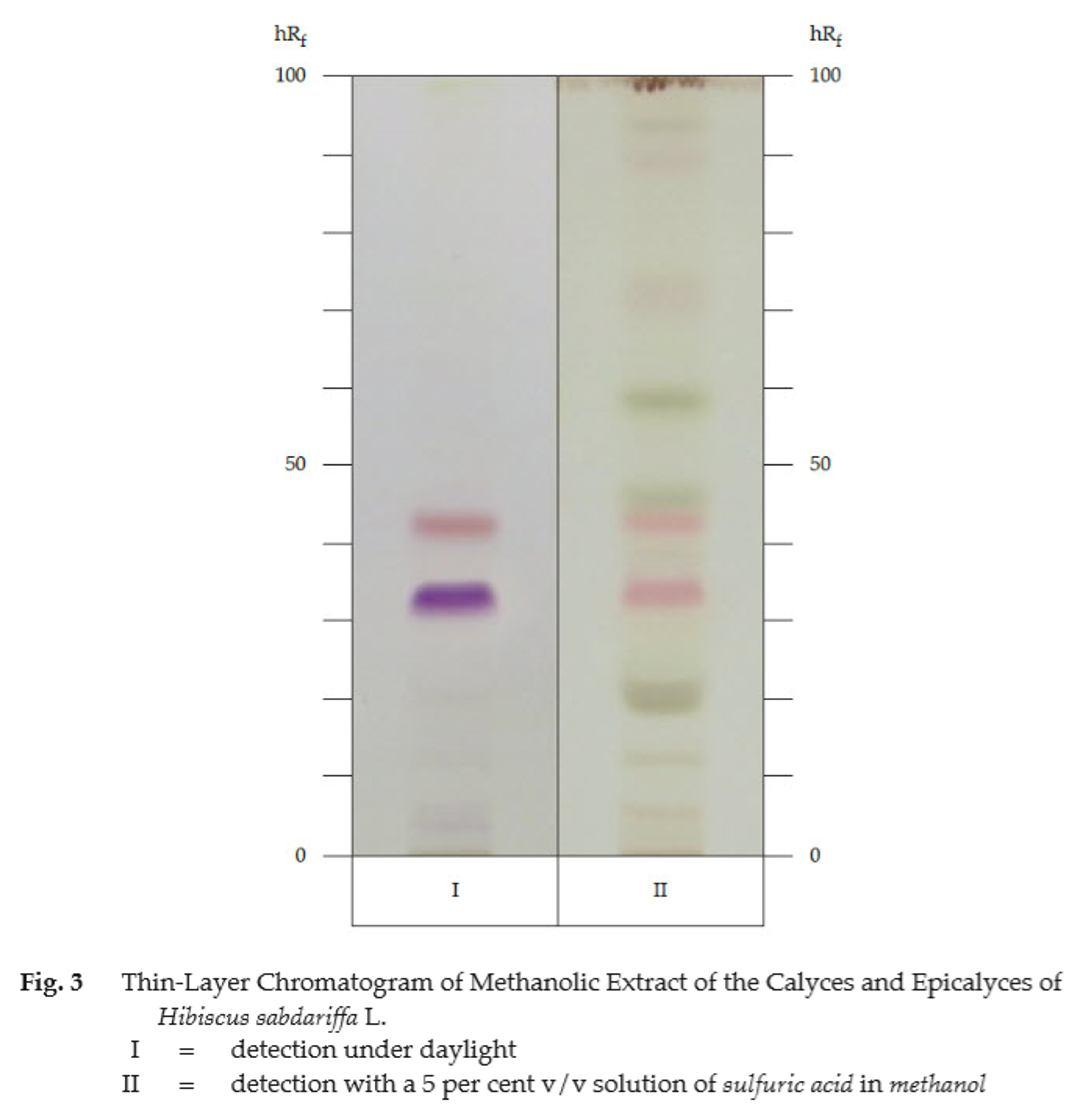ตำรามาตรฐานยาสมุนไพรไทย
Thai Herbal Pharmacopoeia
สำนักยาและวัตถุเสพติด กรมวิทยาศาสตร์การแพทย์ กระทรวงสาธารณสุข
Bureau of Drug and Narcotic, Department of Medical Sciences, Ministry of Public Health(Tinospora crispa (L.) Hook.f. & Thomson)
(Nelumbo nucifera Gaertn.)
(Centella asiatica (L.) Urb.)
(Centella Dry Extract)
(Centella Cream)
(Mesua ferrea L.)
(Piper sarmentosum Roxb.)
(Piper sarmentosum Roxb.)
(Pterocarpus santalinus L. f.)
(Santalum album L.)
(Senna tora (L.) Roxb.)
(Senna alata (L.) Roxb.)
(Senna Alata Tea)
(Piper retrofractum Vahl)
(Myristica fragrans Houtt)
(Andrographis paniculata (Burm. f.) Nees)
(Andrographis Capsules)
(Allium ascalonicum L.)
(Ocimum tenuiflorum L.)
(Curcuma longa L.)
(Turmeric Capsules)
(Turmeric Dry Extract)
(Turmeric Dry Extract Capsules)
(Arcangelisia flava (L.) Merr.)
(Curcuma sp.)
Harrisonia perforata (Blanco) Merr.
(Aristolochia pierrei Lecomte)
(Zingiber officinale Roscoe)
(Ginger Capsules)
(Ginger Tea)
(Cassia fistula L.)
(Nardostachys jatamansi (D. Don) DC.)
(Angelica sinensis (Oliv.) Diels)
Artemisia annua L.
(Ligusticum sinense Oliv. cv. Chuanxiong)
(Neopicrorhiza scrophulariiflora Pennell)
(Atractylodes lancea (Thunb.) DC.)
(Aucklandia lappa Decne)
(Terminalia chebula Retz.)
(Angelica dahurica (Hoffm.) Benth. & Hook. f. ex Franch. & Sav. var. dahurica)
(Kaempferia parviflora Wall. ex Baker)
(Hibiscus sabdariffa L.)
(Roselle Tea)
(Allium sativum L.)
(Zingiber zerumbet (L.) Sm.)
(Wurfbainia testacea (Ridl.) Škorničk.& A. D. Poulsen)
(Cannabis sativa L.)
(Myristica fragrans Houtt)
(Dracaena cochinchinensis (Lour.) S. C. Chen)
(Ficus racemosa L.)
(Hyptis suaveolens (L.) Poit.)
Clerodendrum indicum (L.) Kuntze
(Phyllanthus emblica L.)
(Citrus hystrix DC.)
(Citrus hystrix DC.)
(Areca catechu L.)
(Momordica charantia L.)
Moringa oleifera Lam.
(Aegle marmelos (L.) Corrêa)
(Solanum trilobatum L.)
(Morus alba L.)
Gynostemma pentaphyllum(Thunb.)
Makino
(Clinacanthus nutans (Burm. f.) Lindau)
(Cissus quadrangularis L.)
(Mimusops elengi L.)
(Zingiber montanum (J. König) Link. ex A. Dietr.)
(Piper betle L.)
(Capsicum annuum L.)
(Capsicum Oleoresin)
(Capsicum Gel)
(Piper nigrum L.)
(Piper nigrum L.)
(Eurycoma longifolia Jack)
(Thunbergia laurifolia Lindl.)
(Piper wallichii (Miq.) Hand.-Mazz.)
Senna garrettiana (Craib) H. S. Irwin & Barneby
(Terminalia bellirica (Gaertn.) Roxb.)
(Terminalia chebula Retz.)
(Caesalpinia bonduc (L.) H. Roxb.)
(Tarlmounia elliptica (DC.) H. Rob., S. C. Keeley, Skvaria & R. Chan)
(Hog Creeper Vine Dry Extract Capsiles)
(Hog Creeper Vine Dry Extract)
(Brachypterum scandens (Roxb.) Miq.)
(Lepidium sativum L.)
(Nigella sativa L.)
(Cuminum cyminum L.)
(Foeniculum vulgare Mill.)
(Plantago ovata Forssk.)
(Pimpinella anisum L.)
(Carum carvi L.)
(Anethum graveolens L.)
(Trachyspermum ammi (L.) Sprague)
Albizia procera (Roxb.) Benth.
(Acorus calamus L.)
(Tiliacora triandra (Colebr.) Diels)
Cyanthillium cinereum (L.) H. Rob.
(Orthosiphon aristatus (Blume) Miq.)
Murdannia loriformis (Hassk.) R. S. Rao & Kammathy
(Capparis micracantha DC.)
(Chrysopogon zizanioides (L.) Roberty)
(Cyperus rotundus L.)
(Cannabis sativa L.)
(Syzygium aromaticum (L.) Merr. & L. M. Perry)
(Boesenbergia rotunda (L.) Mansf.)
(Acanthus ebracteatus Vahl)
(Acanthus ilicifolius L.)
(Kaempferia galanga L.)
(Curcuma comosa Roxb.)
Betula alnoides Buch.-Ham. ex D. Don
Cannabis sativa L.
Carthamus tinctorius L
Mitragyna speciosa (Korth.) Havil
Mallotus repandus (Rottler) Müll. Arg
Azadirachta indica A. Juss. var. siamensis Valeton
Azadirachta indica A. Juss. var. siamensis Valeton
Punica granatum L.
Rhinacanthus nasutus (L.) Kurz
Baliospermum solanifolium (Burm.) Suresh
Curcuma aeruginosa Roxb
Boesenbergia kingii Mood & L. M. Prince
Senegalia rugata (Lam.) Britton & Rose
Acacia concinna (Willd.) DC.
Senegalia rugata (Lam.) Britton & Rose
Acacia concinna (Willd.) DC.
Senna alexandriana Mill. var. alexandriana
Cassia acutifolia Delile, Cassia angustifolia Vahl
Butea superba Roxb. ex Willd.
[Plaso superba (Roxb. ex Willd.) Kuntze, Rudolphia superba (Roxb. ex Willd.) Poir.
Pueraria candollei Graham
ex Benth. var. mirifica (Airy Shaw & Suvat.) Niyomdham
Streblus asper Lour.
Suregada multiflora (A. Juss.) Baill. (Gelonium
multiflorum A. Juss.
Roselle is the dried persistent calyx and epicalyx collected during fruiting of Hibiscus sabdariffa L. (Family Malvaceae), Crude Drug Number: DMSc 0437.
(Note Only dried reddish to dark red Roselle is recommended for medicinal uses.)
Constituents Roselle contains anthocyanins, of which delphinidin-3-sambubioside and cyanidin-3-sambubioside are major components. It also contains organic acids (e.g., citric acid, hibiscus acid, hydroxycitric acid, malic acid), phenolic acids (e.g., protocatechuic acid), flavonoids, mucilages, pectins, potassium salts, etc.
Description of the plant (Figs. 1a, 1b) Annual herb or subshrub 1 to 2(‒5) m tall; stem erect, cylindrical, branched, woody at base, green when young becoming reddish to purplish with age, glabrous or covered with aculeate warts or caducous bristles. Leaves simple, alternate, dimorphic, proximal leaves ovate, margin serrate, dis tal leaves palmately 3- to 5-lobed, 6 to 15 cm long, lobes lanceolate, elliptic to oblong, 2 to 8 cm long, 0.5 to 1.5 cm wide, apex obtuse or acuminate, base round or broadly cuneate, margin serrate or dentate, blade glabrous or pubescent, basal veins 3 to 5, green or red, bearing a gland at base of midrib; petiole 4 to 15 cm long, somewhat spiny near the top; stipule filliform, about 1 cm long. Flower solitary, axillary; pedicel less than 3 cm long; epicalyx reddish, 8- to 12-lobed, 6 to 10 mm long, connate at base, adnate to the base of calyx, lobe lanceolate, 0.5 to 1.8 cm long, 2 to 3 mm wide, sparsely hirsute, with spiny appendix near apex; calyx fleshy, reddish or purplish, hirsute, lobes 5, connate below the middle into cup-shaped, each lobe triangular, with a prominent cos ta extending as far as its apex, base of each sinus between lobes terminated by a bifurcate nerve and bearing a dis tinct nectary gland, calyx after anthesis becoming thick-fleshy, 2.5 to 5.5 cm long, dis tinctly longer than fruit; corolla pink or yellow with dark red centre, petals 5, obovate, 4 to 6 cm long, 1 to 4 cm wide; staminal tube 1.5 to 2 cm long, anthers along the tube, pistils in the tube; ovary superior, 5-loculed, ovules 3 to many per locule, style branches 5, stigmas capitate. Fruit capsule, reddish, ovoid to globose, 1.5 to 3 cm long, 1 to 1.5 cm wide, loculicidally 5-valved, beaked, sparsely to densely appressed hairy, enclosed by red, fleshy, accrescent calyx. Seeds numerous, reniform, 2 to 6 mm long, brownish to blackish.
Description Odour, mild, berry-like; taste, sour.
Macroscopical (Fig. 1a) Dried calyx and epicalyx, irregularly shaped and sized, reddish to dark red, somewhat hard. A nectary found in the lower surface at the basal part of each calyx.
Microscopical (Figs. 2a, 2b, 2c) Transverse section of the epicalyx shows epidermis layer, cortex, vascular bundles and pith. Epidermis, a layer of small rectangular cells and some with unicellular trichomes. Cortex, several thin-walled of polygonal parenchyma cells, some containing anthocyanins or rosette aggregate crystals. Vascular bundles, collateral. Aerenchyma, some containing rosette aggregate crystals located at the innermost region.
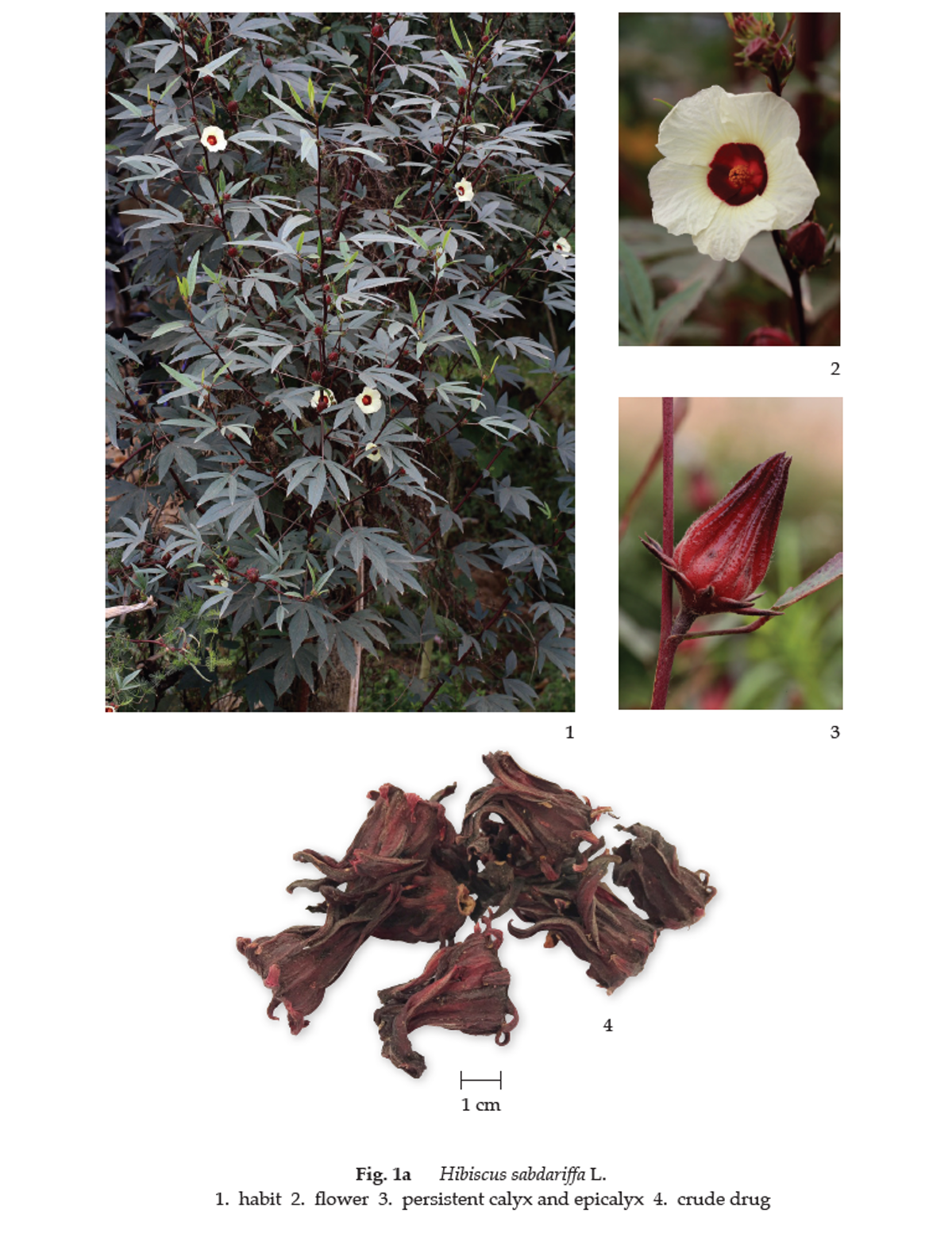
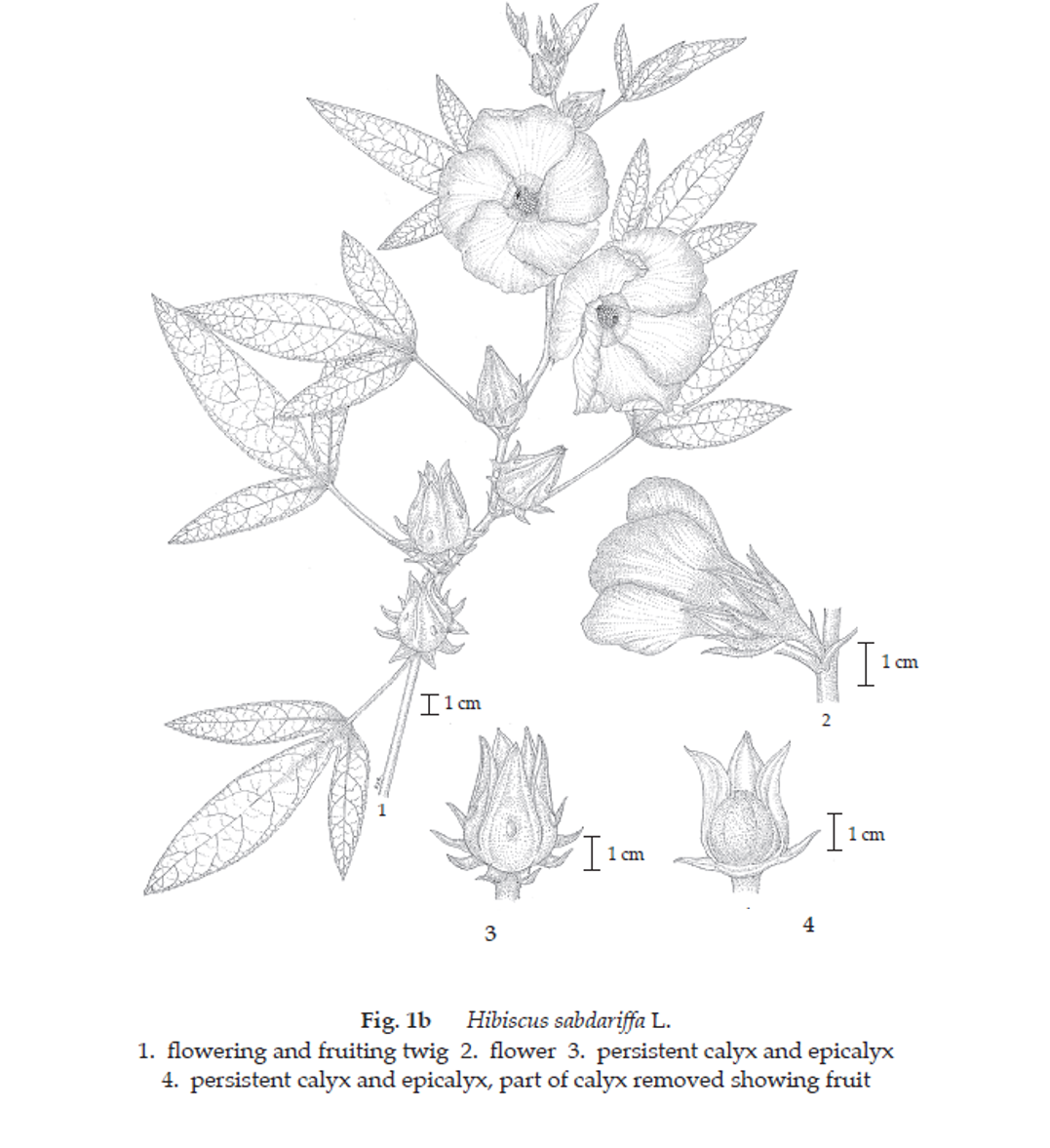
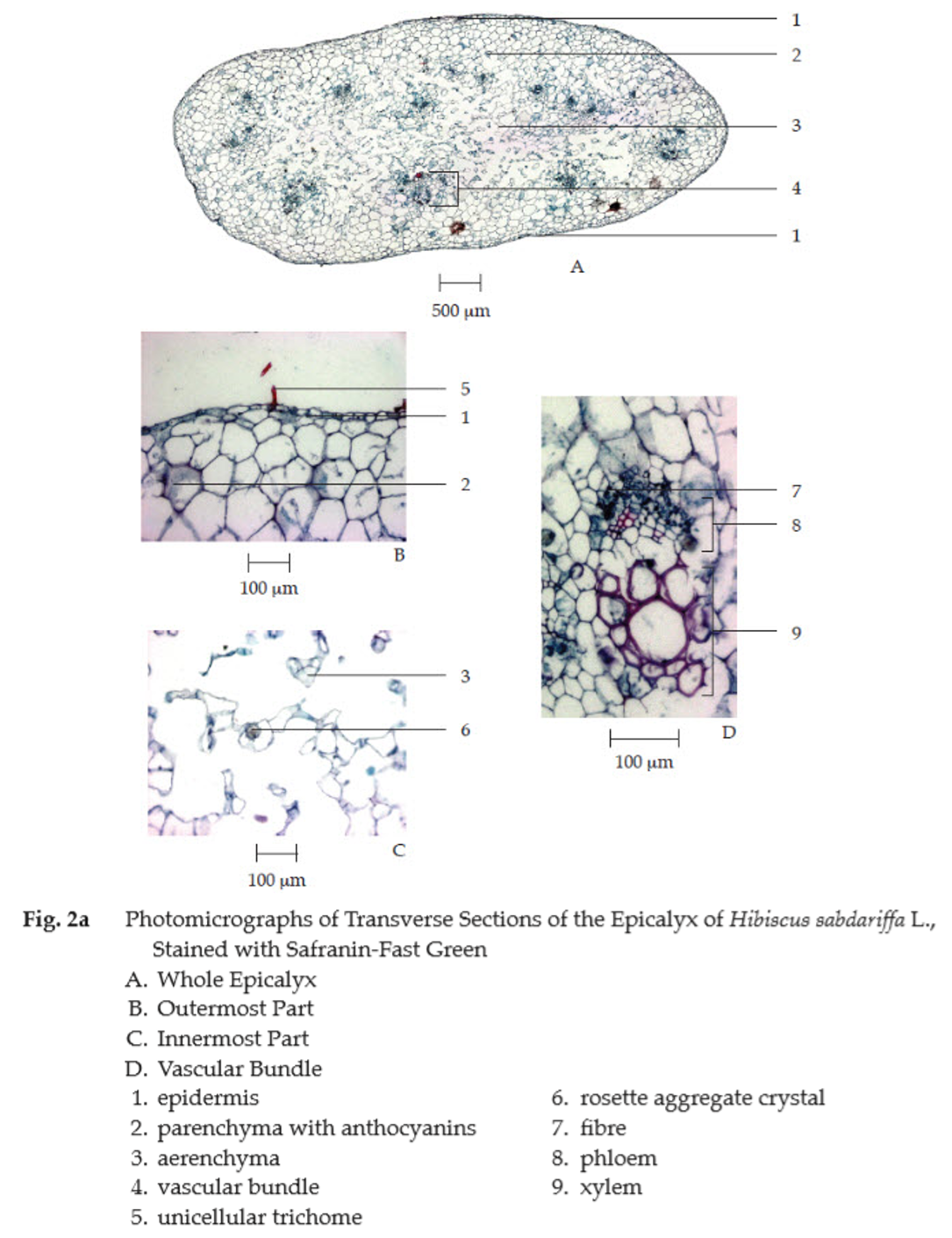
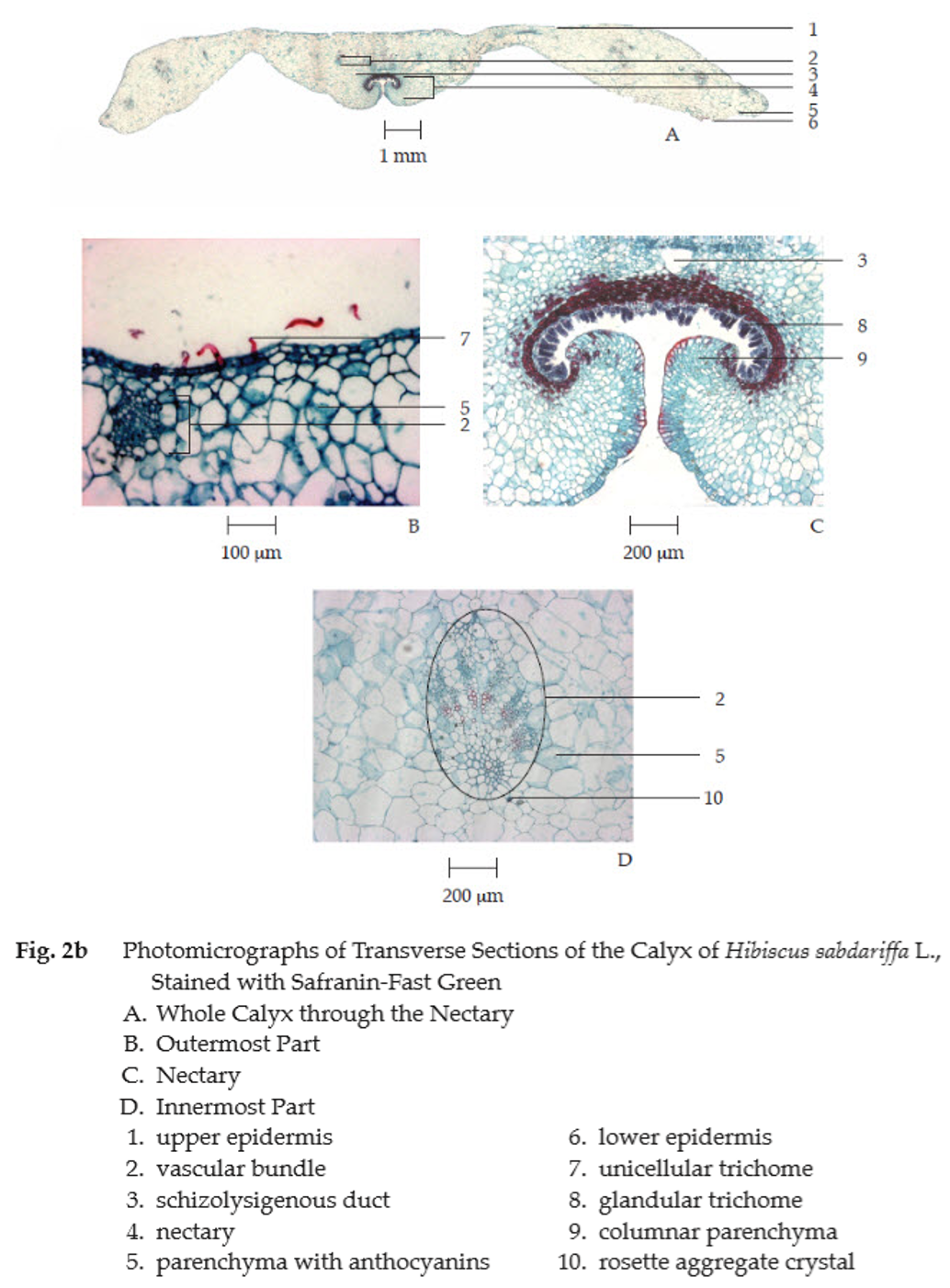
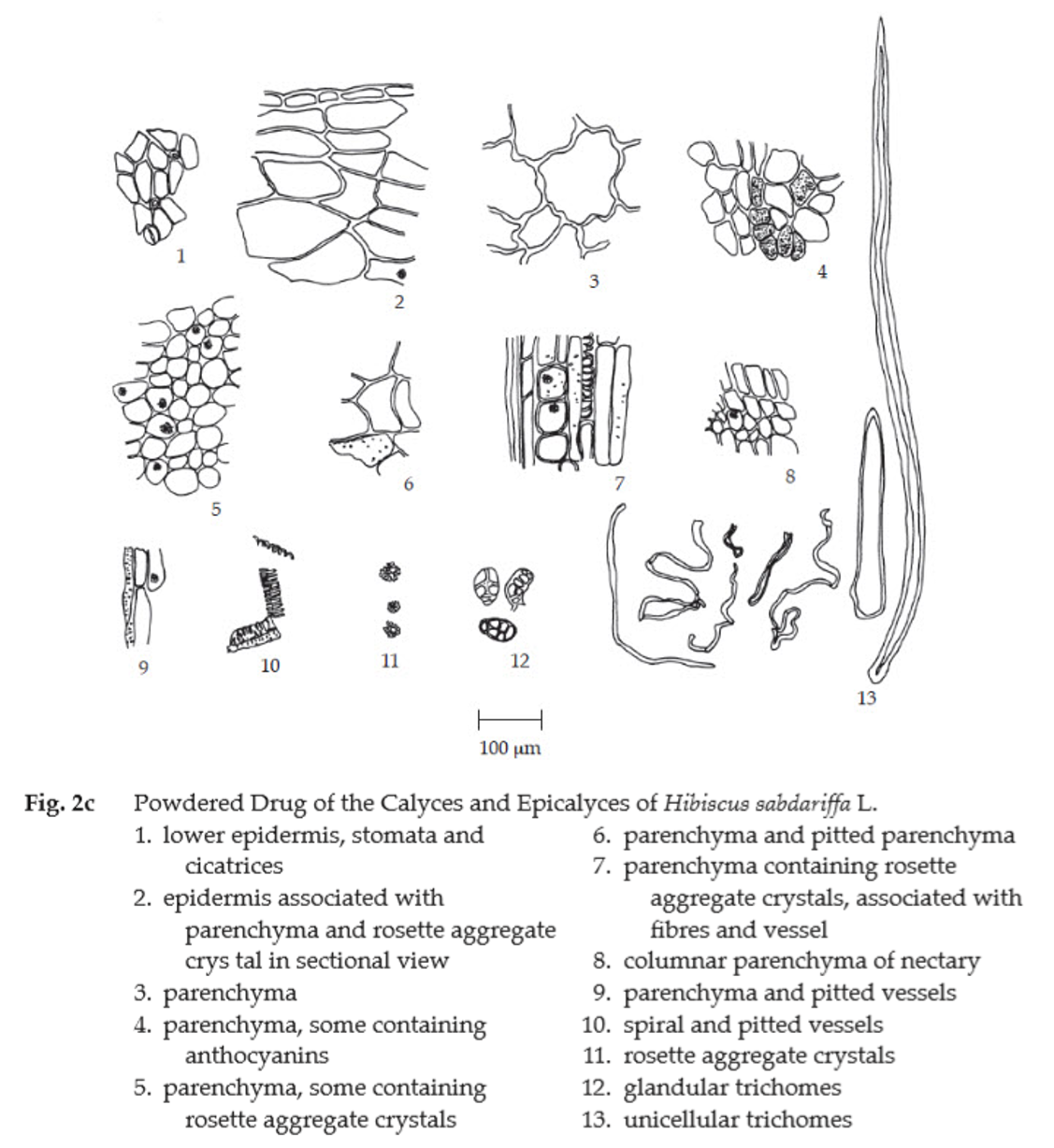
Transverse section of the calyx through the nectary shows a layer of upper and lower epidermises, cortex, vascular bundles, and nectary. Upper and lower epidermises, small rectangular cells with some modified unicellular trichomes. Cortex, round parenchyma cells, some containing anthocyanins, rosette aggregate crystals, and schizolysigenous ducts. Vascular bundles, collateral, containing phloem and xylem tissues. Nectary, composed of glandular trichome, small rectangular epidermis and several layers of slightly thick-walled, columnar parenchyma cells, connected with large vascular bundles and schizolysigenous ducts.
Roselle in powder possesses the diagnostic microscopical characters of the unground drug. Columnar parenchyma of nectary, unicellular and glandular trichomes, rosette aggregate crystals, and parenchyma containing anthocyanins are characteristic.
Contra-indication It is contra-indicated in patients with impaired renal function.
Packaging and storage Roselle shall be kept in well-closed containers, protected from light,and stored in a dry place.
Identification
A. To 300 mg of the sample, in powder, add 8 mL of water, shake for 15 minutes and filter (solution 1). To 0.2 mL of solution 1, add 2 M sodium hydroxide dropwise: a bluish green colour develops and changes to red after immediately adding a few drops of 2 M hydrochloric acid.
B. To 0.2 mL of solution 1, add 4 drops of iron(III) chloride TS: a brownish green colour develops.
C. Carry out the test as described in the “Thin-Layer Chromatography” (Appendix 3.1), using silica gel GF254 as the coating substance and a mixture of 60 volumes of ethyl acetate, 20 volumes of 2-propanol, 20 volumes of water, and 10 volumes of formic acid as the mobile phase and allowing the solvent front to ascend 10 cm above the line of application. Apply to the plate as a band of 10 mm, 10 μL of the test solution freshly prepared by macerating 1 g of the sample, in powder, in 10 mL of a 0.1 per cent v/v solution of hydrochloric acid in methanol, shaking frequently for 15 minutes and filtering. After removal of the plate, allow it to dry in air and examine under daylight. Two violet and several purple bands are observed. Spray the plate with a 5 per cent v/v solution of sulfuric acid in methanol and heat at 100° for 10 minutes; two pink and other several bands of different colours are observed (Table 1); see also Fig. 3.
Table 1 hRf Values of Components in Methanolic Extract of the Calyces and Epicalyces of Hibiscus sabdariffa L.
| Band | hRf Value | Detection | |
| Daylight | 5 Per Cent V/V Solution of Sulfuric Acid in Methanol |
||
| 1 2 3 4 5 6 7 8 9 10 11 12 13 14 15 16 |
3-5 5-7 5-8 11-13 12-14 15-22 17-22 31-35 34-39 40-44 43-47 56-59 70-73 73-75 89-90 93-95 |
pale violet - pale purple - pale purple pale purple - violet - purple - - - - - - |
- pale brown - pale brown - - grey pink pale grey pink pale grey pale grey pale violet pale brown pale violet grey |
Loss on drying Not more than 12.0 per cent w/w after drying at 105° to constant weight (Appendix 4.15).
Foreign matter Not more than 2.0 per cent w/w (Appendix 7.2).
Acid-insoluble ash Not more than 1.5 per cent w/w (Appendix 7.6).
Total ash Not more than 10.0 per cent w/w (Appendix 7.7).
Ethanol-soluble extractive Not less than 7.0 per cent w/w (Appendix 7.12).
Water-soluble extractive Not less than 45.0 per cent w/w (Appendix 7.12).
Acid content Not less than 12.0 per cent w/w of acids, calculated as citric acid on the dried basis, when determined by the following method.
Shake 1 g of Roselle, in No. 250 powder, accurately weighed, with 100.0 mL of carbon dioxide-free water for 15 minutes and filter. To 50.0 mL of the filtrate, add 100 mL of carbon dioxide free-water. Titrate with 0.1 M sodium hydroxide VS until pH 7.0, determining the end-point potentiometrically (Appendix 6.4). Perform a blank determination, and make any necessary correction. Each mL of 0.1 M sodium hydroxide VS is equivalent to 6.4 mg of citric acid.
Dose 1.5 to 3 g of powdered roselle, taken as an infusion, three times a day.
